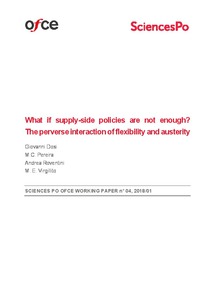What if supply-side policies are not enough? The perverse interaction of flexibility and austerity
"In this work we develop a set of labour market and fiscal policy experiments upon the labour and credit augmented “Schumpeter meeting Keynes” agent-based model. The labour market is declined under two institutional variants, the “Fordist” and the “Competitive” set-ups meant to capture the hist...
| Main Authors: | , , , |
|---|---|
| Institution: | ETUI-European Trade Union Institute |
| Format: | TEXT |
| Language: | English |
| Published: |
Paris
2018
OFCE |
| Subjects: | |
| Online Access: | https://www.labourline.org/KENTIKA-19395860124911130429-What-if-supply-side-policies-a.htm |
| Summary: | "In this work we develop a set of labour market and fiscal policy experiments upon the labour and credit augmented “Schumpeter meeting Keynes” agent-based model. The labour market is declined under two institutional variants, the “Fordist” and the “Competitive” set-ups meant to capture the historical transition from the Fordist toward the post “Thatcher- Reagan” period. Inside these two regimes, we study the different effects of supply-side active labour market policies (ALMPs) vs. demand-management passive labour market ones (PLMPs). In particular, we analyse the effects of ALMPs aimed at promoting job search, and at providing training to unemployed people. Next, we compare the effects of these policies with unemployment benefits simply meant to sustain income and therefore aggregate demand. Considering the burden of unemployment benefits in terms of public budget, we link such provision with the objectives of the European Stability and Growth Pact. Our results show that (i) an appropriate level of skills is not enough to sustain growth when workers face adverse labour demand; (ii) supply-side policies are not able to reverse the perverse interaction between flexibility and austerity; (iii) PLMPs outperform ALMPs in reducing unemployment and workers’ skills deterioration; and (iv) demand-management policies are better suited to mitigate inequality and to improve and sustain long-run growth." |
|---|---|
| Physical Description: | 44 p. Digital |

